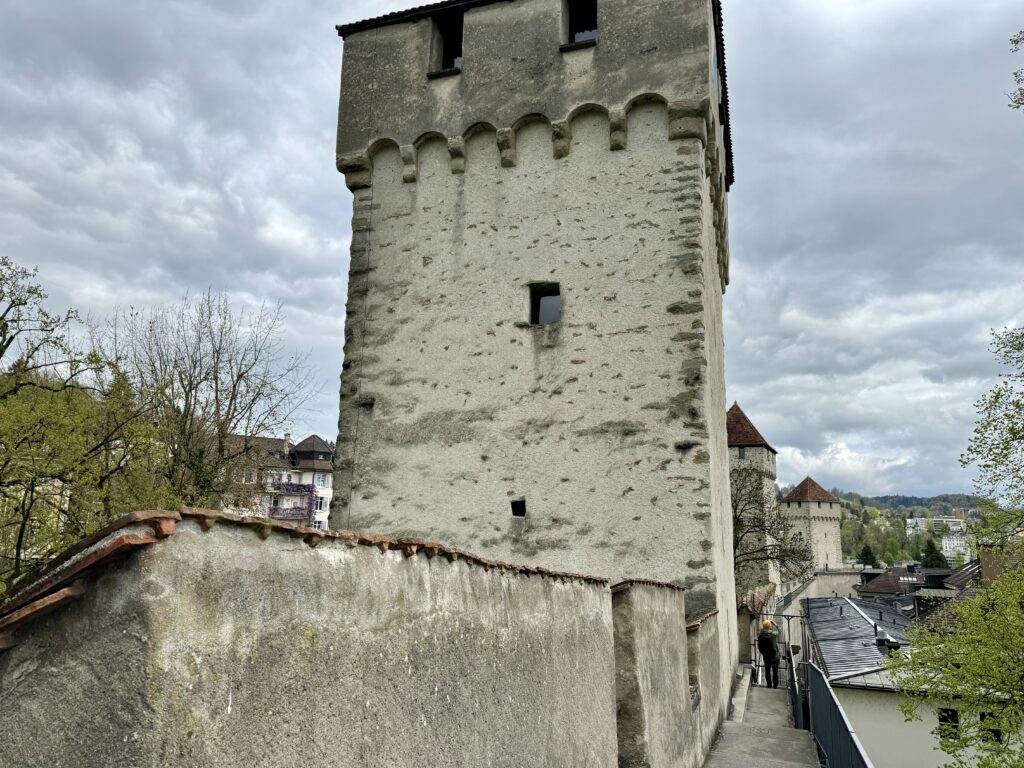Lucern
-
Lucern
April 8, 2024 /The best way to see the architecture of Lucerne’s colourful Altstadt (old town) is on foot. This 2-kilometre walking route travels through both Neustadt (new town) and Altstadt. It takes about an hour to walk, depending on the time spent at each spot.
Begin at the Bahnhofplatz, the huge transit hub with a parking garage beneath. The Zentralstrasse, Lucerne’s main train station, is to the south. The original train station was destroyed by fire in early 1971. Its grand main entrance was saved and stands in the middle of the Bahnhofplatz, like a gateway to the city. To the east of the plaza is a huge building, one of the few modern-looking buildings in this part of the city, the Culture and Convention Center. Opened in 2000, the Kultur und Kongresszentrum Lucerne (or KKL Lucerne) has three parts: an 1840-seat concert hall, multi-function Lucerne Hall and the convention centre. There are a number of restaurants and cafes which are convenient to the dock on the lake. The striking, glass-and-steel building’s design has won international praise for the concert hall’s amazing acoustics. Its unique ceiling, special sound-absorbing doorways and an inaudible ventilation system create complete silence enriching performance sound.
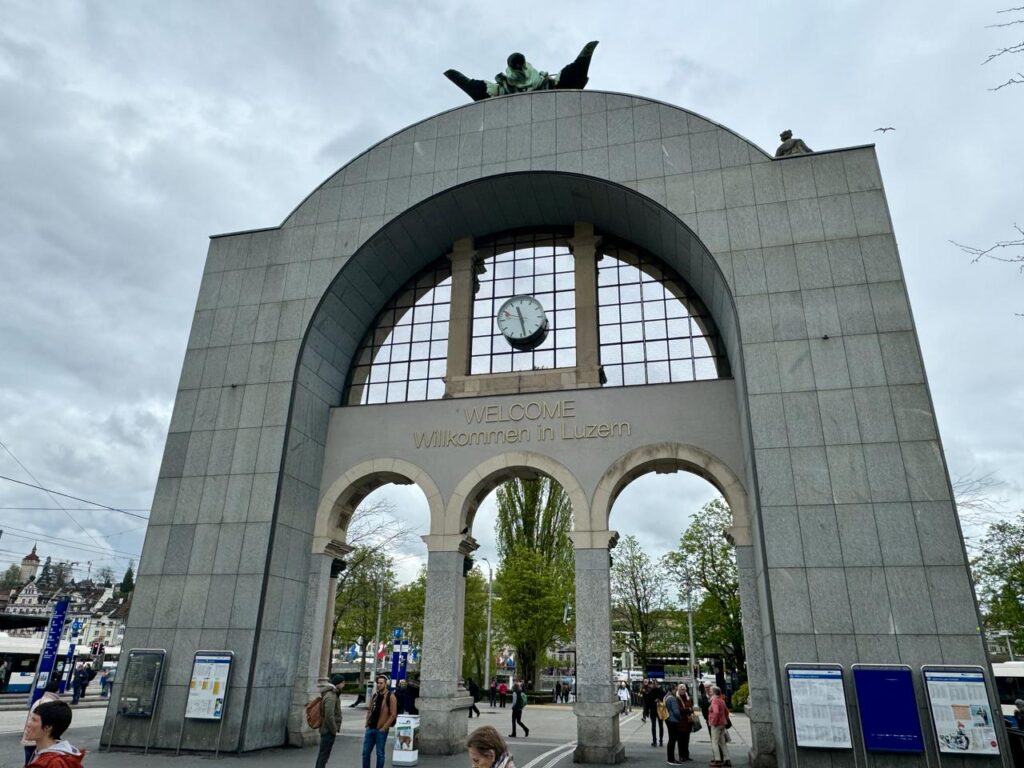
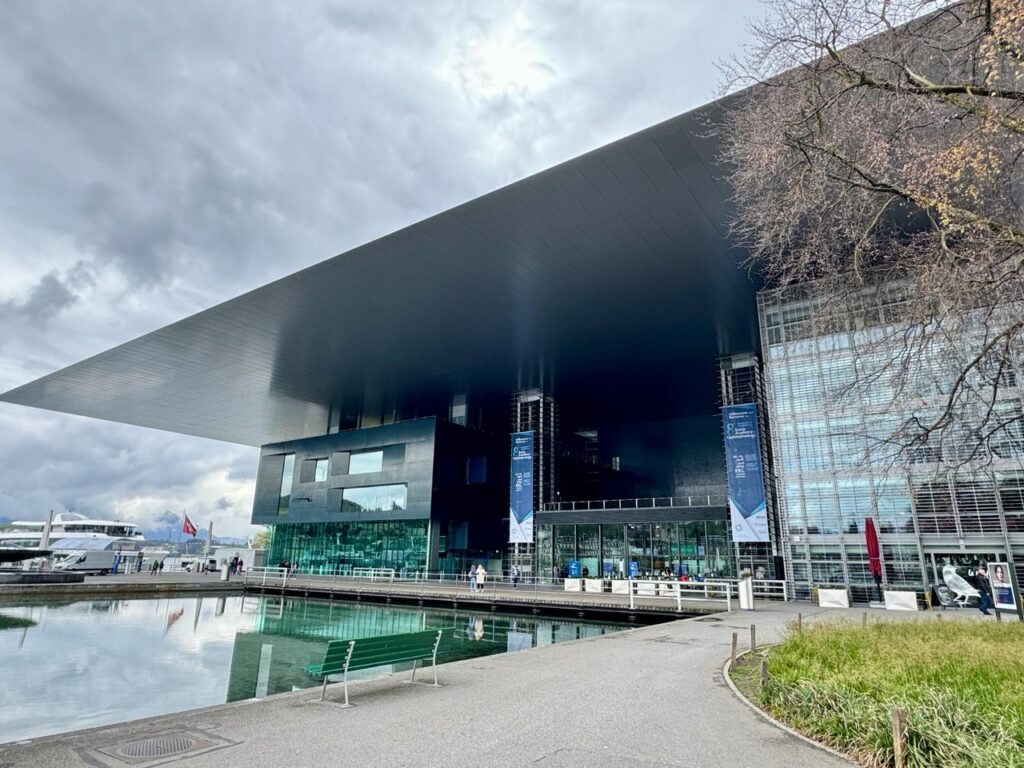
Walk back to the Bahnhofplatz and continue west along the river to the 14th-century Kapellbrücke, one of Lucerne’s most recognized landmarks. The winding, wooden, covered bridge is over 200 metres long. It was built across the Reuss River as part of the city’s defensive system. Partway along the bridge, the 8-sided, stone Water Tower is original and older than the bridge. Over the centuries, the tower was used as the city treasury, dungeon prison and archive. A 1993 fire began in a boat moored to the bridge. The fire spread to the bridge destroying a large portion of it. Both ends of the bridge survived as did the stone tower. The tower’s gabbled roof was destroyed. Walk across a portion of the bridge to see the triangular roof panels. The original panels were painted in the 17th-century, recording the development of Lucerne and Switzerland up to that point. The 1993 fire burned 81 of the 111 panels. The panels found in the centre are originals which were in storage during the fire. The paintings were sponsored by wealthy families. To recognize their charity, the family coats of arms were added to the paintings.
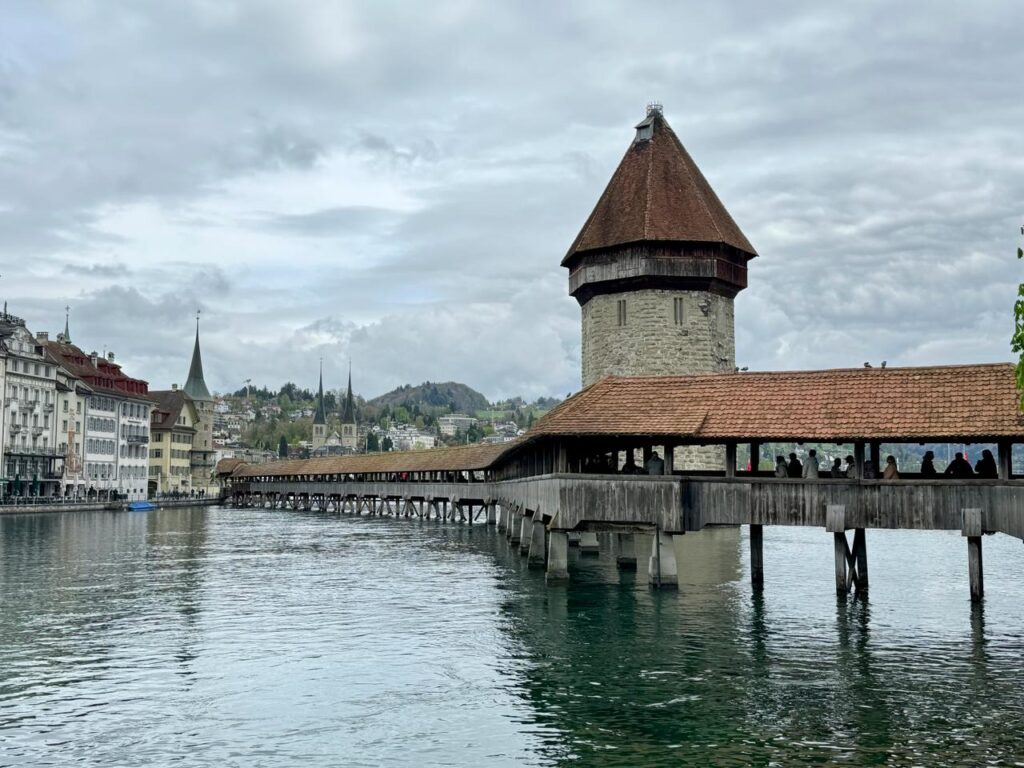
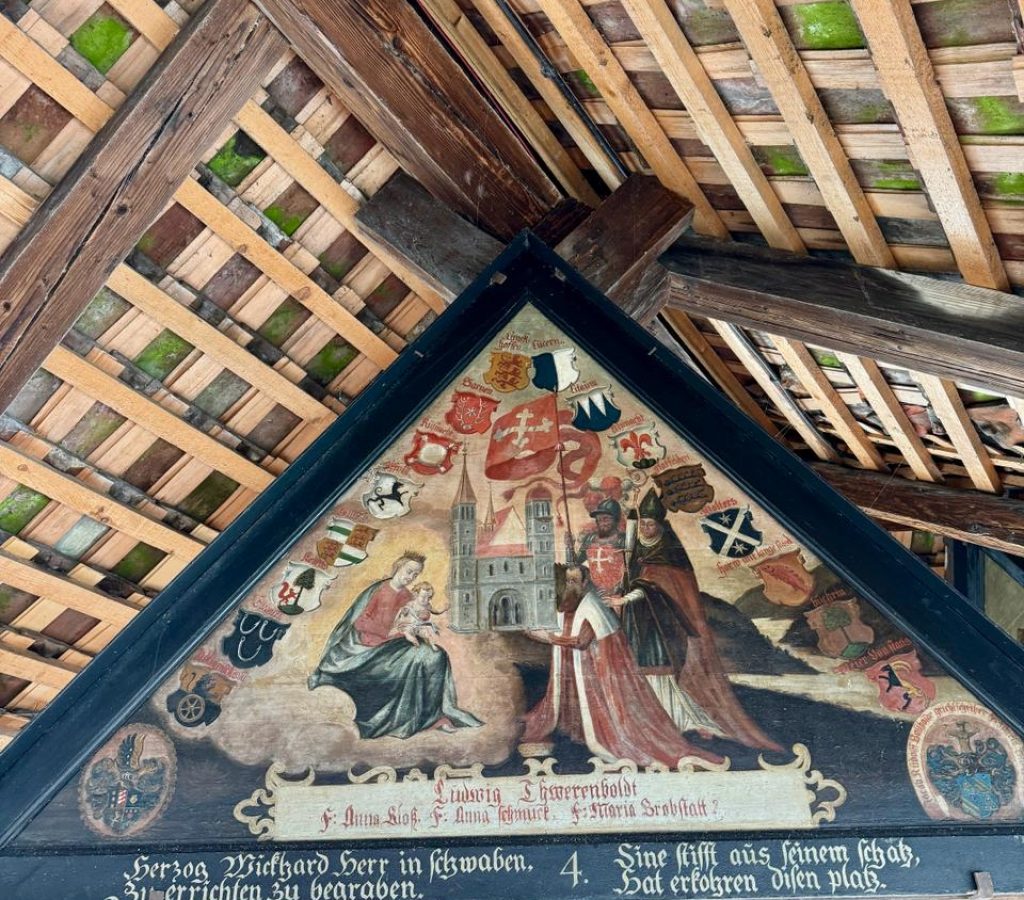
Follow the river west to the Jesuitenkirche. The large, 17th-century church was the first Baroque church in Switzerland. Its two, onion-domed towers were added in 1893. It is dedicated to Francis Xavier, co-founder of the Jesuit order. While the exterior is Baroque, the interior was redone in the mid-18th century in Rococo style. The interior is beautiful. The ceiling murals celebrate Xavier’s life and afterlife. The church’s large organ is used by Lucerne’s music school. Enjoy the music if they happen to be practising.
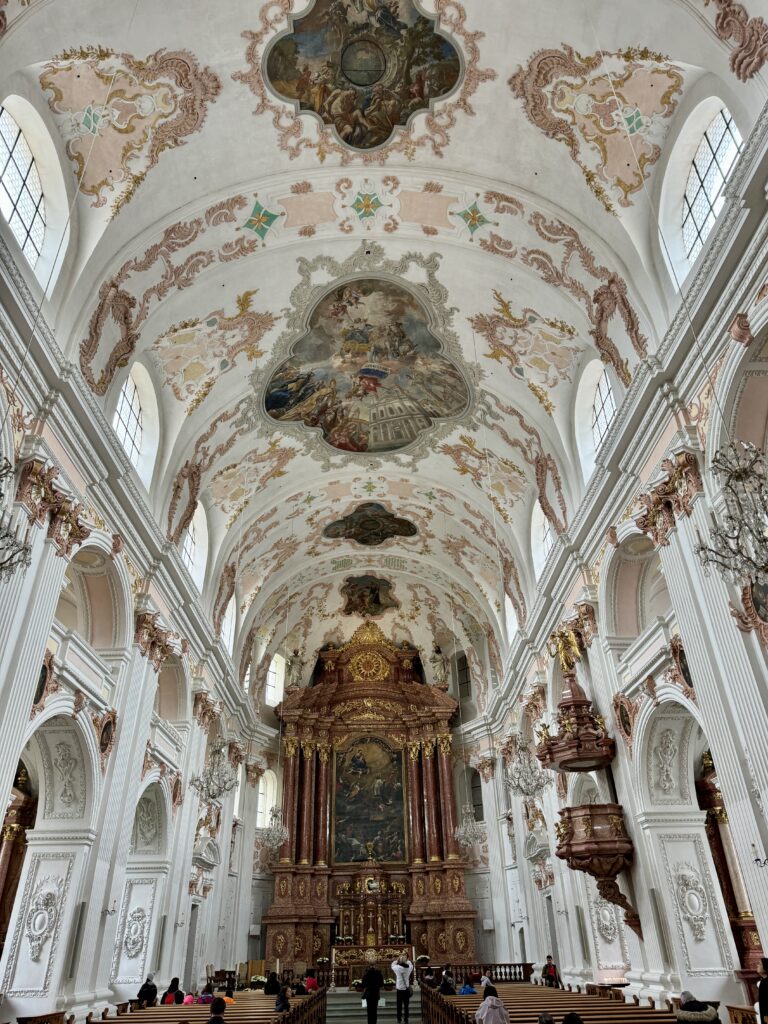
Walk west on Bahnhofstrasse to the next intersection. To the left, at the end of the street is the Franziskanerkirche. The beautiful, 13th-century, Gothic-style church has a large pipe organ and stunning paintings. Over the centuries the interior has undergone extensive renovation but has kept its 17th-century choir stalls and the wooden pulpit.
Return to Bahnhofstrasse and continue west. Turn right onto Pfistergasse. Walk to almost the next major cross street. Turn right and walk through an arched entrance along a covered walkway. This leads to the next covered bridge.
The 15th-century, covered, pedestrian Spreuer Bridge is original. It is smaller Chapel Bridge and has avoided fire for more than 6 centuries. Its roof panels are a series of paintings, called Dance of Death by Kaspar Meglinger, created to remind the townspeople, who crossed the bridge daily, that death cannot be escaped regardless of social class. The far end of the bridge was designed for wagons delivering supplies to three mills nearby. Since the middle ages, there have been mills in this area harnessing the power of the river. A fire in 1875 destroyed all but one. It was removed in 1890 making way for the city’s first hydroelectric power plant. Those turbines generated power for 90 years. They were replaced by the current power plant in 1996. Look toward the lake. It receives its water from snow melt. A movable dam was designed in the mid-19th century to control lake levels and protect lakeside towns from flooding. In the spring, the dam is opened by removing wooden pickets, allowing the river to flow. As the lake’s water level drops, the wooden pickets are put back in place extending the dam across the river and slowing the flow. We visited in late May and the dam was partway across the river channel. By winter, the dam is entirely in place, cutting the flow to almost nothing across the main river channel. This keeps the lake level high enough for some boats.
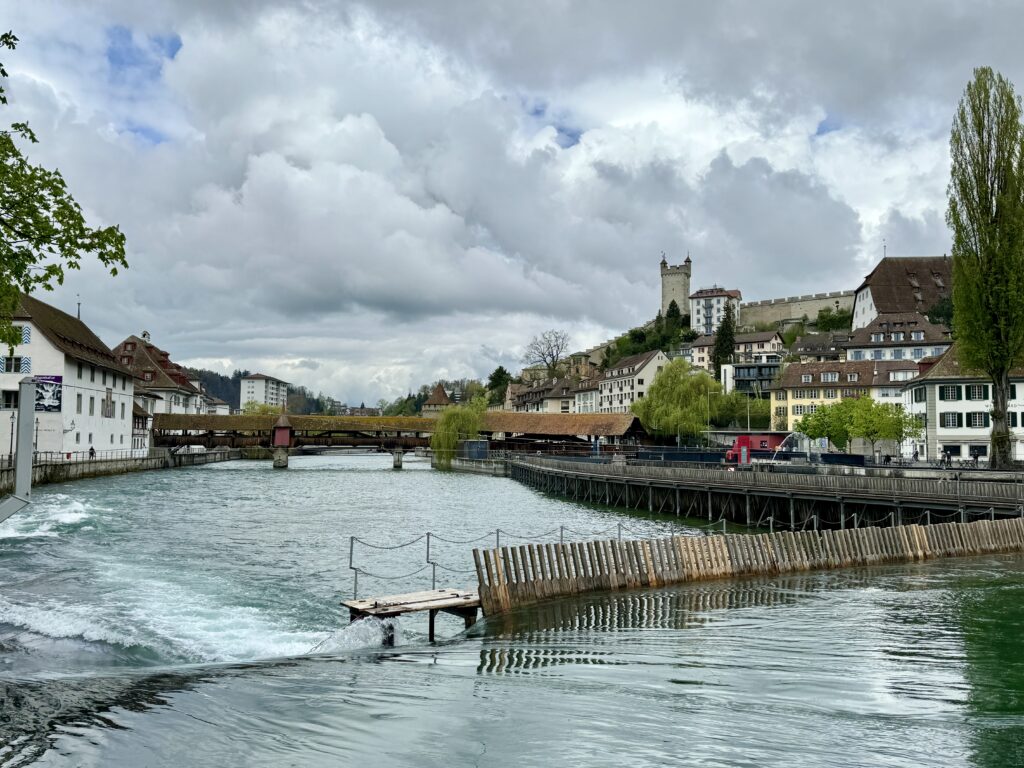
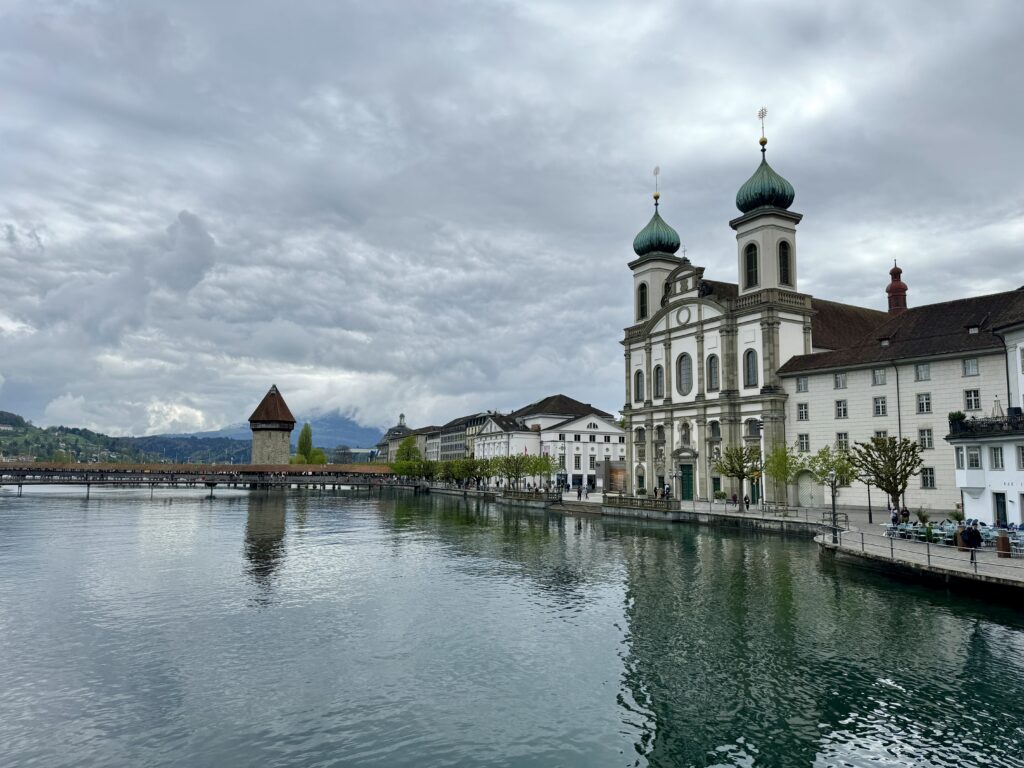
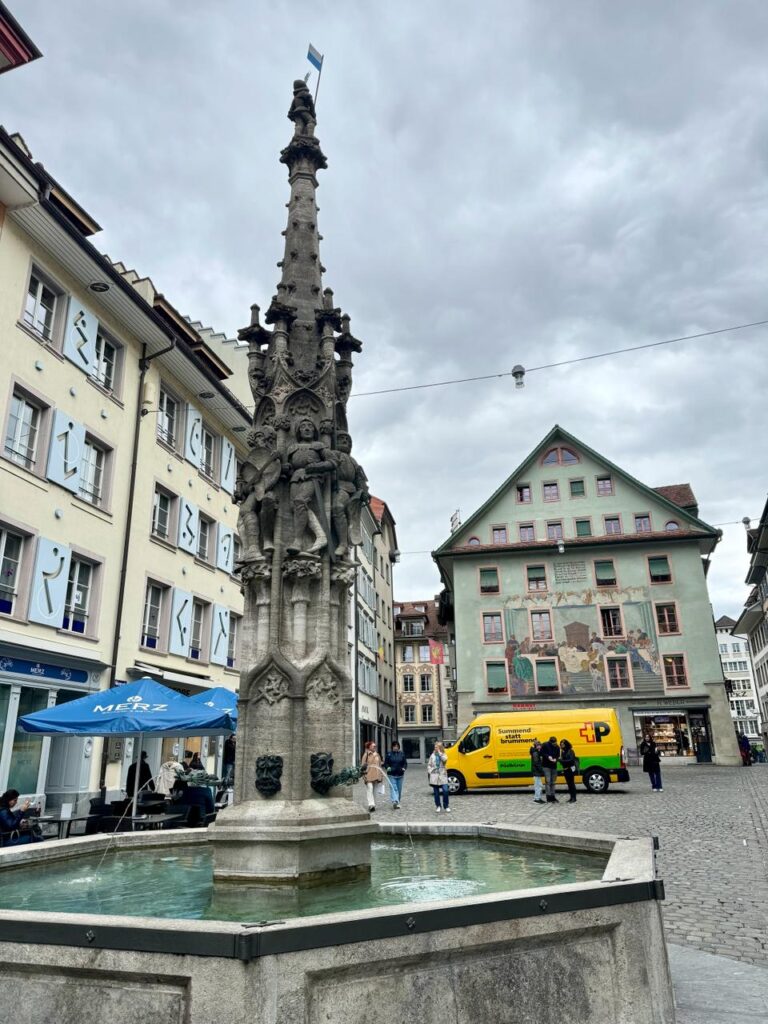
From the bridge, walk to the right into the pedestrian square called the Muhlenplatz. This is the start of the old town. At the top of the square, turn right and walk a block to Weinmarktgasse. Walk a block to the pretty city square, the Weinmarkt. This was a marketplace for wine. The 15th-century fountain has carvings of soldiers. They were to remind citizens that the town was tough and strong. Enjoy the beautiful paintings on building fronts in the square.
Continue up the street to the Hirschenplatz. This square got its name from the Hirschen Hotel which is long gone. Its sign still hangs in the square. Turn right, walk a block then turn left onto Kornmarkt. Walk to the square outside the Rathaus Stradt beside the Town Hall clock. The first town council meeting was held in this late Renaissance-style town hall in 1606. The building continues to be used for council meetings.
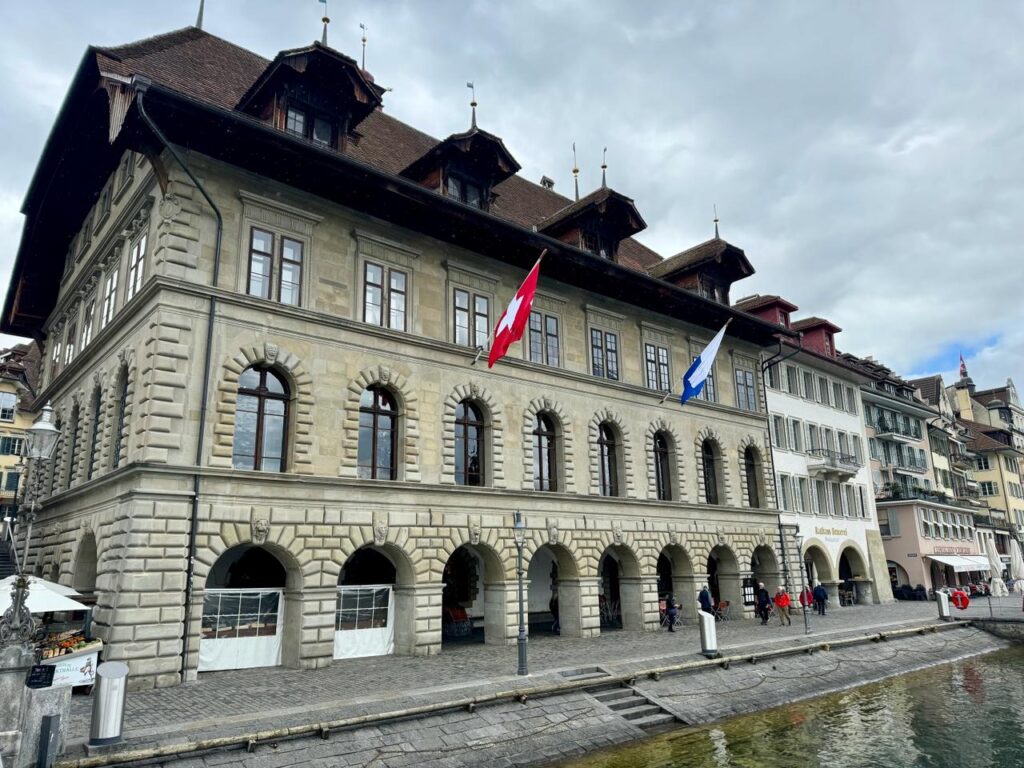
Walk Furrengass to St. Peter’s Chapel. The bridge was called Kapellbrücke due to its proximity to church.
The Fritschibrunnen is in the plaza to the north of the church. Locals gather at this fountain early in the morning on the first Thursday seven weeks before Easter to start the Fasnacht festival. This is Lucerne’s annual Mardi Gras and one of their biggest parties of the year. There are parades, dancing, singing and drinking through the entire seven-day festival. Locals often take time off and visitors are encouraged to join in.
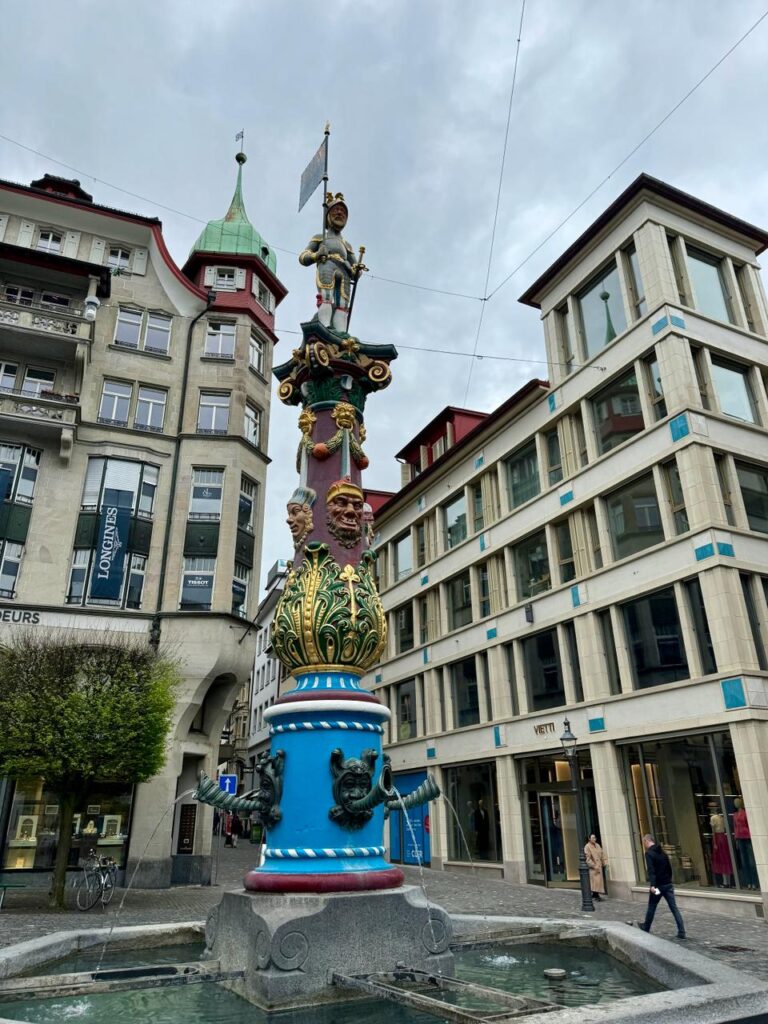
From St. Peter’s Chapel, walk east along the river to Lake Lucerne. Walk the sidewalk north and east following the lakeshore. The main street, Löwenstrasse, turns left. Follow it, turning immediately right onto St. Leodegarstrasse. Walk to the church with the beautiful bell towers. The beautiful, 17th-century late-Renaissance Hofkirche St Leodegar has twin, Gothic, bell towers. The church was part of a monastery founded in 750. A 1633 fire destroyed all but the bell towers. Inside, see the beautiful, white stonework and the vaulted ceiling. The 17th-century organ is one of Switzerland’s finest.
Walk back out to the main street, Löwenstrasse, and walk north about 4 blocks to the Lowenplatz and the Bourbaki Panorama.
The 10-metre-tall Bourbaki Panorama was painted in 1881 by Edouard Castres. It portrays, in a very lifelike, 360-degree view, the surrender of French troops to the neutral Swiss. At the end of the Franco-Prussian War in 1871, the French troops refused to surrender to the winning Germans. The panorama was touched up in the year 2000. Many panoramic theatres were built in the 19th century in Europe and the United States.
Walk to one of Lucerne’s more well-known tourist attractions, the Lowendenkmal, about a block north, on Denkmalstasse, the Lion Monument. The sculpture of a dying lion was carved into the stone, cliff-face in the 1820s. It is 10 metres long and 6 metres tall. It memorializes the Swiss soldiers who died defending King Louis 16th in the 1792 Paris attack during the French Revolution. This beautiful park was a sandstone quarry when the lion was carved.
Adjoining the park to the north is the Gletschergarten.
Sixteen potholes, called kettles, were revealed when glaciers melted in the area 20,000 years ago. In 1873, the Amrein family built the Glacier Garden around the kettles. Enjoy walking the paths through the rocks and plants. The Amreins collected all manner of items which are displayed in the museum’s eclectic collection. A mirror maze recreating Granada Spain’s Alhambra was created for the 1896 Geneva National Exhibition. It was moved to the garden in 1899.
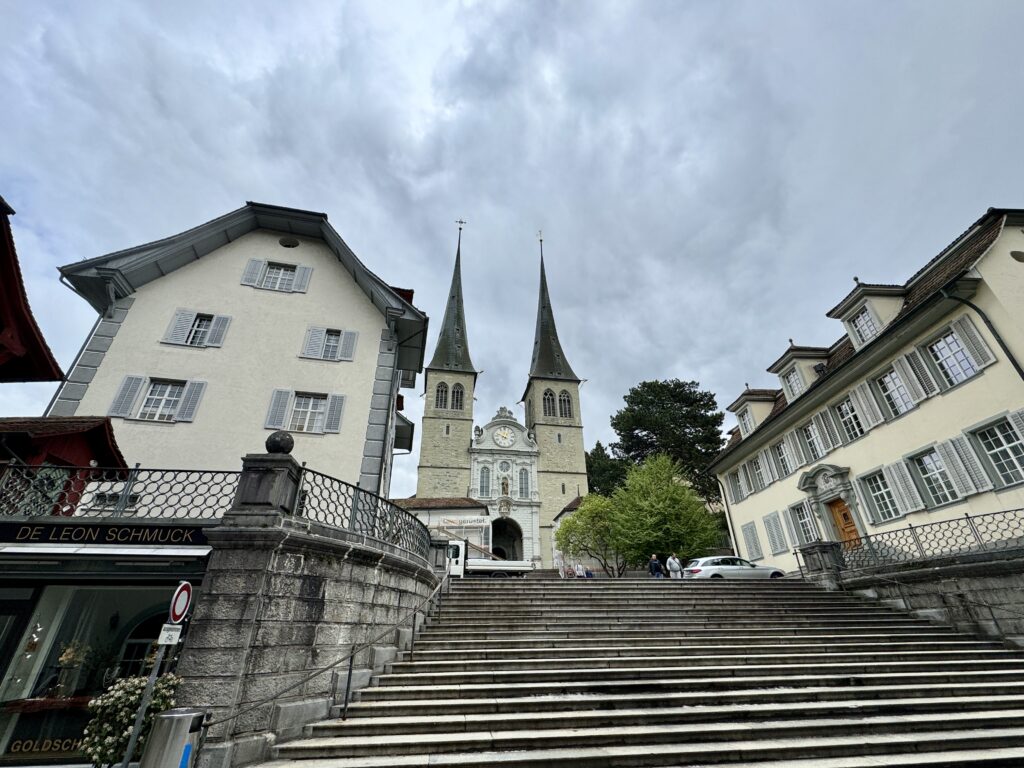
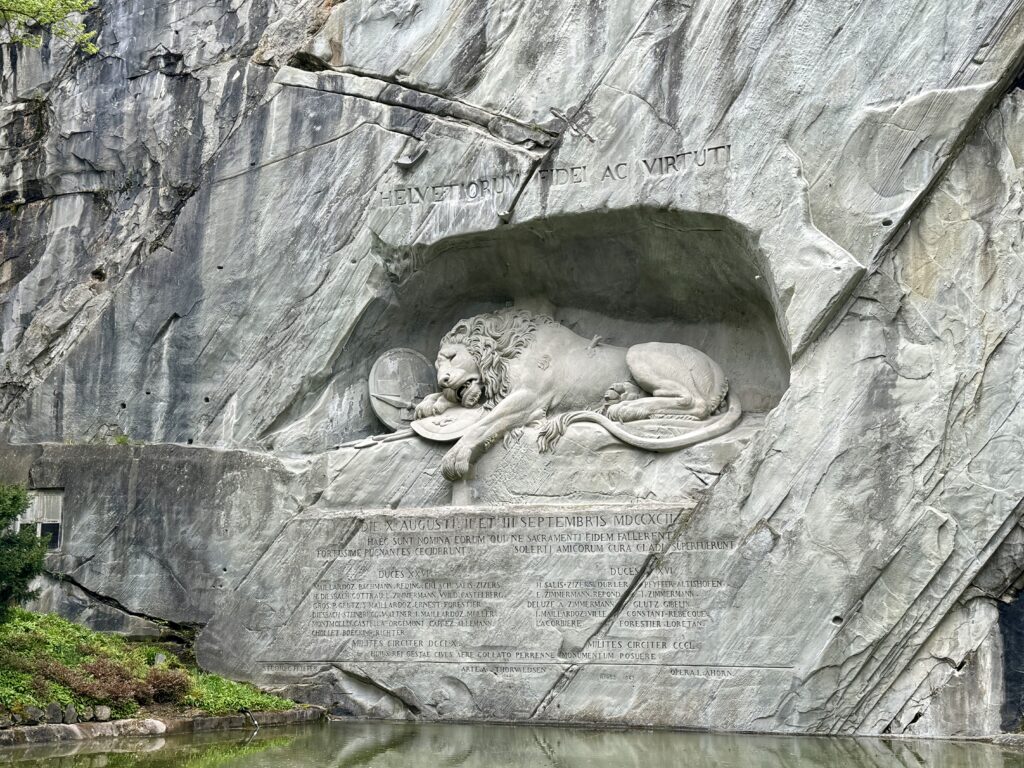
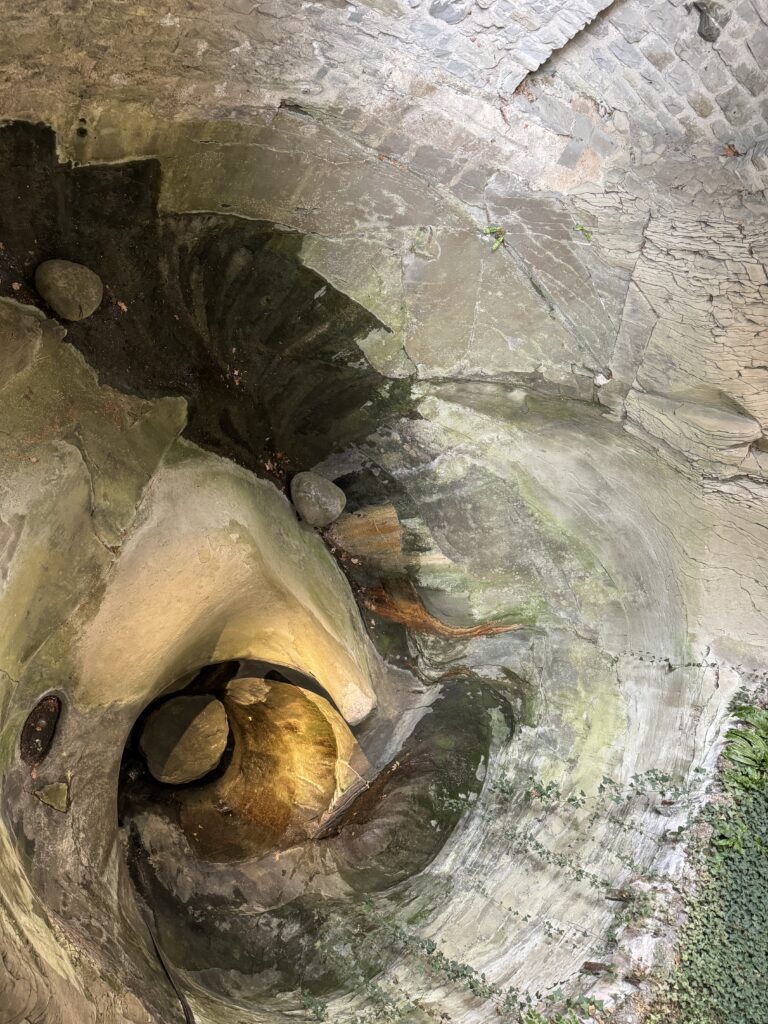
Walk back down Denkmalstrasse to Lowenplatz. From the square, continue 2 blocks south to Hofstrasse. Turn right onto Museggstrasse. This street runs parallel to the watchtowers and old walls of the city constructed around 1400. Veer right onto Schirmertorweg and climb up to the Museggmauer. Walk the path on top of the old city ramparts, for stunning views of the city and Lake Lucerne. There are 9 stone towers, some open to the public. The wall and the towers (including the Schirmerturm, Männliturm, Wachtturm, Zytturm) date back to late 14th century.
